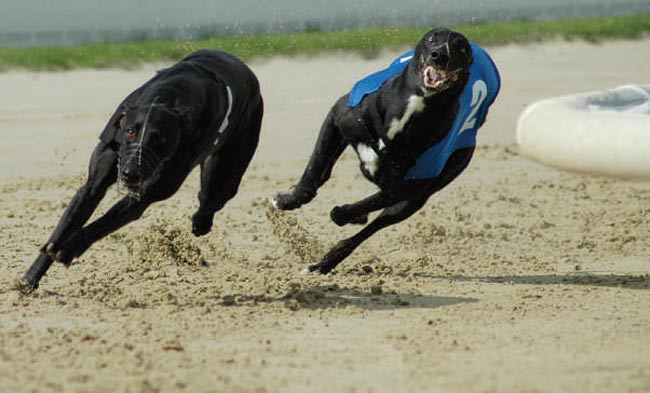Greyhounds Go Full Throttle in the Corners

The world's fastest runners couldn't keep up with a greyhound in a straight sprint. Were such a contest held on a track with banked turns, it would become laughable.
Unlike humans, greyhounds hardly need to slow down to run around a corner, a new study finds.
"They certainly don't slow down as you'd expect them to," said James Usherwood of the Royal Veterinary College in the United Kingdom. "We can calculate how much they should slow down, but they don't do it."
The "duty factor"
As a human sprinter takes a banked turn the body experiences gravity and centripetal forces that increase effective body weight and adds to the load the legs must carry. To compensate for this and maintain a constant force load on their legs—and to keep from falling off the track—humans increase the "duty factor," the time each foot spends in contact with the ground.
But increasing the duty factor means that the same muscles that power us through the turn are also working harder to keep us standing up. This extra force demand combined with longer contact with the ground results in a reduction of speed.
To determine how greyhounds manage to speed around corners, Usherwood examined high-speed video recordings of the dogs running on a track. Although he estimates that all four limbs experience large increases in peak force when taking a corner, the videotape showed that the duty factor for the dogs' feet didn't change compared to when they ran straight ahead.
Sign up for the Live Science daily newsletter now
Get the world’s most fascinating discoveries delivered straight to your inbox.
Different muscles
So how do greyhounds do it?
Their locomotion muscles are not needed for weight support, so their racing muscles don't feel as much of the extra force from the turn as we do.
"Greyhounds have nice, straight limbs, and their bones and tendons can take on these forces passively, leaving their leg muscles free to power through the turn," Usherwood told LiveScience. "It's like if you sit a human on a bicycle—body-weight support is done by the saddle and the muscles for power are not affected by body weight."
This research is detailed in the Dec. 8 issue of the journal Nature.










